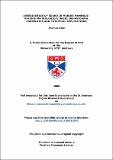Aversiveness of sound in marine mammals : psycho-physiological basis, behavioural correlates and potential applications
Abstract
Understanding what psycho-physiological and behavioural factors influence
aversiveness of sound in marine mammals is important for conservation and practical
applications. The aim of this study was to determine predictors for impact of
anthropogenic noise and to develop a target-specific predator deterrence system for
use on fish farms. Three classes of stimuli were tested: 1.) grey seal underwater
communication calls expected to be used in territorial defence, 2.) high duty-cycle
moderately loud artificial sounds (some of which were based on models of
unpleasantness for humans), 3.) brief, intense pulses designed to elicit the acoustic
startle reflex.
Communication calls had no deterrence effect but instead caused attraction
responses. Tests with high duty-cycle artificial sounds showed that food-motivated
animals habituate quickly, although sound exposure caused subtle changes in diving
patterns over a longer time. Field trials using the same stimuli were used to
determine avoidance thresholds but also indicated that sound features like
‘roughness’ play a role. The startle eliciting stimuli, however, had the most dramatic
effects. To this stimulus most seals exhibited rapid flight responses, hauled out,
sensitised and showed signs of fear conditioning. Startle thresholds were found to be
80-85 dB above the assumed hearing threshold. The data showed that startle
thresholds are a crucial predictor for the occurrence of strong avoidance behaviour
and suggests that the startle response evolved to increase an animal’s propensity for
flight. Finally, a prototype predator deterrence system based on the startle sounds
was developed to repel seals whilst not affecting toothed whales. In fish farm trials,
seals were deterred at close ranges but local abundance of cetaceans did not
change showing that it is possible to cause differential responses between species
based on differences in their audiograms.
The results are used to develop noise exposure criteria and to elucidate acoustic
parameters that can be used to predict responses to anthropogenic noise.
Type
Thesis, PhD Doctor of Philosophy
Rights
Creative Commons Attribution-NonCommercial-NoDerivs 3.0 Unported
http://creativecommons.org/licenses/by-nc-nd/3.0/
Collections
Except where otherwise noted within the work, this item's licence for re-use is described as Creative Commons Attribution-NonCommercial-NoDerivs 3.0 Unported
Items in the St Andrews Research Repository are protected by copyright, with all rights reserved, unless otherwise indicated.


